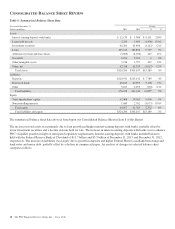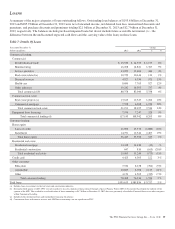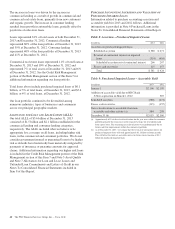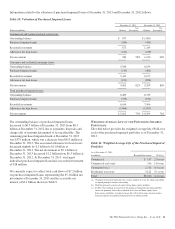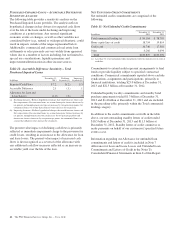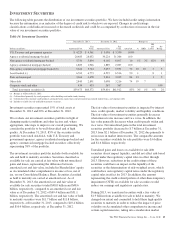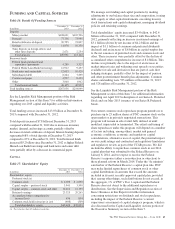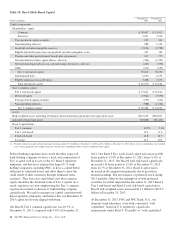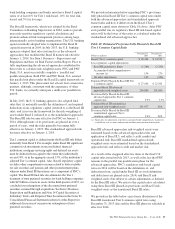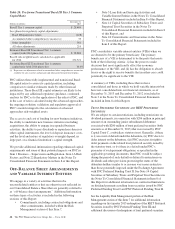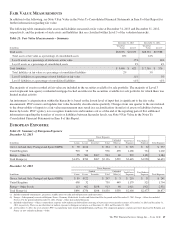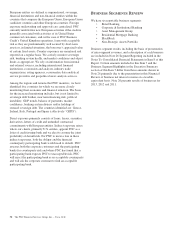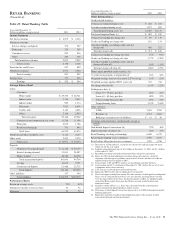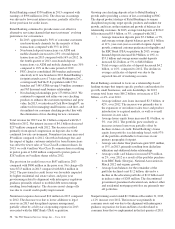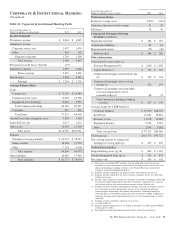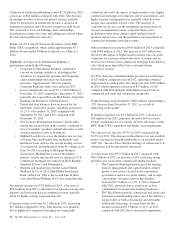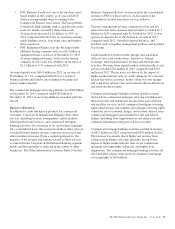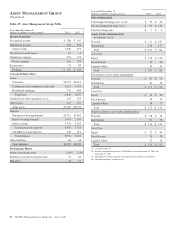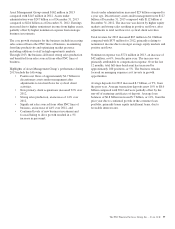PNC Bank 2013 Annual Report Download - page 66
Download and view the complete annual report
Please find page 66 of the 2013 PNC Bank annual report below. You can navigate through the pages in the report by either clicking on the pages listed below, or by using the keyword search tool below to find specific information within the annual report.
Table 20: Pro forma Transitional Basel III Tier 1 Common
Capital Ratio
Dollars in millions
December 31
2013
Basel I Tier 1 common capital $ 28,484
Less phased-in regulatory capital adjustments:
Basel III quantitative limits (228)
Accumulated other comprehensive income (a) 39
Other intangibles 381
All other adjustments 210
Estimated Basel III Transitional Tier 1 common
capital (with 2014 phase-ins) $ 28,886
Basel I risk-weighted assets calculated as applicable
for 2014 272,321
Pro forma Basel III Transitional Tier 1 common
capital ratio (with 2014 phase-ins) 10.6%
(a) Represents net adjustments related to accumulated other comprehensive income for
available for sale securities and pension and other postretirement benefit plans.
PNC utilizes these fully implemented and transitional Basel
III capital ratios to assess its capital position, including
comparison to similar estimates made by other financial
institutions. These Basel III capital estimates are likely to be
impacted by any additional regulatory guidance, continued
analysis by PNC as to the application of the rules to PNC, and
in the case of ratios calculated using the advanced approaches,
the ongoing evolution, validation and regulatory approval of
PNC’s models integral to the calculation of advanced
approaches risk-weighted assets.
The access to and cost of funding for new business initiatives,
the ability to undertake new business initiatives including
acquisitions, the ability to engage in expanded business
activities, the ability to pay dividends or repurchase shares or
other capital instruments, the level of deposit insurance costs,
and the level and nature of regulatory oversight depend, in
large part, on a financial institution’s capital strength.
We provide additional information regarding enhanced capital
requirements and some of their potential impacts on PNC in
Item 1 Business – Supervision and Regulation, Item 1A Risk
Factors and Note 22 Regulatory Matters in the Notes To
Consolidated Financial Statements in Item 8 of this Report.
O
FF
-B
ALANCE
S
HEET
A
RRANGEMENTS
AND
V
ARIABLE
I
NTEREST
E
NTITIES
We engage in a variety of activities that involve
unconsolidated entities or that are otherwise not reflected in
our Consolidated Balance Sheet that are generally referred to
as “off-balance sheet arrangements.” Additional information
on these types of activities is included in the following
sections of this Report:
• Commitments, including contractual obligations and
other commitments, included within the Risk
Management section of this Item 7,
• Note 3 Loan Sale and Servicing Activities and
Variable Interest Entities in the Notes To Consolidated
Financial Statements included in Item 8 of this Report,
• Note 14 Capital Securities of Subsidiary Trusts and
Perpetual Trust Securities in the Notes To
Consolidated Financial Statements included in Item 8
of this Report, and
• Note 24 Commitments and Guarantees in the Notes
To Consolidated Financial Statements included in
Item 8 of this Report.
PNC consolidates variable interest entities (VIEs) when we
are deemed to be the primary beneficiary. The primary
beneficiary of a VIE is determined to be the party that meets
both of the following criteria: (i) has the power to make
decisions that most significantly affect the economic
performance of the VIE; and (ii) has the obligation to absorb
losses or the right to receive benefits that in either case could
potentially be significant to the VIE.
A summary of VIEs, including those that we have
consolidated and those in which we hold variable interests but
have not consolidated into our financial statements, as of
December 31, 2013 and December 31, 2012 is included in
Note 3 in the Notes To Consolidated Financial Statements
included in Item 8 of this Report.
T
RUST
P
REFERRED
S
ECURITIES AND
REIT P
REFERRED
S
ECURITIES
We are subject to certain restrictions, including restrictions on
dividend payments, in connection with $206 million in principal
amount of an outstanding junior subordinated debenture
associated with $200 million of trust preferred securities (both
amounts as of December 31, 2013) that were issued by PNC
Capital Trust C, a subsidiary statutory trust. Generally, if there
is (i) an event of default under the debenture, (ii) PNC elects to
defer interest on the debenture, (iii) PNC exercises its right to
defer payments on the related trust preferred security issued by
the statutory trust, or (iv) there is a default under PNC’s
guarantee of such payment obligations, as specified in the
applicable governing documents, then PNC would be subject
during the period of such default or deferral to restrictions on
dividends and other provisions protecting the status of the
debenture holders similar to or in some ways more restrictive
than those potentially imposed under the Exchange Agreement
with PNC Preferred Funding Trust II. See Note 14 Capital
Securities of Subsidiary Trusts and Perpetual Trust Securities in
the Notes To Consolidated Financial Statements in Item 8 of
this Report for additional information on contractual limitations
on dividend payments resulting from securities issued by PNC
Preferred Funding Trust I and PNC Preferred Funding Trust II.
See the Liquidity Risk Management portion of the Risk
Management section of this Item 7 for additional information
regarding our first quarter 2013 redemption of the REIT Preferred
Securities issued by PNC Preferred Funding Trust III and
additional discussion of redemptions of trust preferred securities.
48 The PNC Financial Services Group, Inc. – Form 10-K


